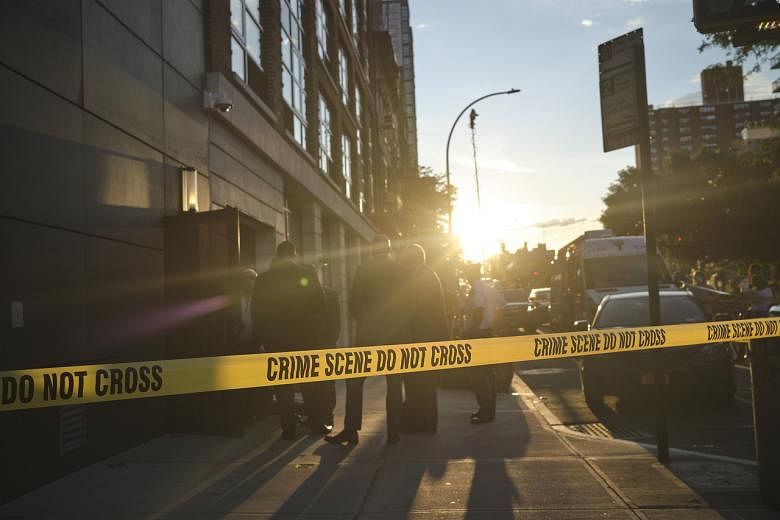CALIFORNIA (NYTIMES) - The United States experienced its biggest one-year increase on record in homicides in 2020, according to new figures released Monday (Sept 27) by the FBI, with some cities hitting record highs.
Although major crimes were down overall, there were an additional 4,901 homicides in 2020 compared with the year before, the largest leap since national records started in 1960.
The significant rise has roughly coincided with the 18 months of the Covid-19 pandemic. The higher murder rate has continued into 2021, although the pace has slowed as the year has progressed.
Overall, the toll of about 21,500 people killed last year is still well below the record set during the violence of the early 1990s. Still, several cities - including Albuquerque, New Mexico; Des Moines, Iowa; Indianapolis; Memphis, Tennessee; Milwaukee; and Syracuse, New York - recorded their highest homicide numbers ever, according to the report.
There is no simple explanation for the steep rise. A number of key factors are driving the violence, including the economic and social toll taken by the pandemic and a sharp increase in gun purchases.
"It is a perfect storm," said Albuquerque Police Chief Harold Medina. He cited Covid-19, the fallout from social justice protests and other contributors. "There is not just one factor that we can point at to say why we are where we are."
The report from the FBI, which tabulates crime numbers reported by almost 16,000 law enforcement agencies, also showed that killings were more widespread, occurring in all regions of the United States and not limited to major cities.
About 77 per cent of reported homicides in 2020 were committed with a firearm, the highest share ever reported, up from 67 per cent a decade ago, said Jeff Asher, a crime analyst based in New Orleans.
Gun sales spiked during the pandemic, although experts noted that it often takes years for legal gun sales to filter into the illegal market for guns that plague cities such as Chicago. Nonfatal shootings spiked as well.
The wider geographic distribution of killings differs from past decades, Asher said. In 1990, New York City and Los Angeles accounted for 13.8 per cent of the country's homicides, compared with 3.8 per cent in 2020, he said.
Homicides this year have risen about 10 per cent from 2020 in 87 cities whose current numbers are available, Asher said. The FBI reports every September on statistics from the previous year, and 2021 figures are not yet fully available.
The pandemic undoubtedly played a significant role, causing economic and mental stress, forcing people together for longer periods and creating a climate of uncertainty and unease. Millions of Americans lost their jobs, businesses and, in some cases, their housing because of the pandemic.
The widespread sense of desperation helped fuel social friction and crime. Many Americans also experienced the trauma of losing loved ones from Covid-19.
"People are desperate and they don't have a lot of options, so they turn toward violence as a way to solve things," said Enrique Cardiel, a community organizer and public health worker in the neighborhood with the most killings in Albuquerque.
At the same time, police departments sometimes struggled with the number of officers available because of quarantines during the pandemic, which curbed public services such as mental health counseling and aggravated related problems such as homelessness.
"This is a country where everybody is suffering a little post-Covid traumatic syndrome, and not knowing what is going to happen," said Peter Winograd, a professor emeritus at the University of New Mexico who works as a consultant for the Albuquerque Police Department. "That is huge."
The report also breaks down last year's homicide victims by race, ethnicity and sex, although not all law enforcement agencies provided such data. Of the people killed in 2020, at least 9,913 were black, 7,029 were white, 497 were from other races and 315 were of unknown race. There were at least 14,146 men killed and 3,573 women.
While various medium-size cities were rocked by a record number of homicides, certain major cities, while still enduring high murder rates, were well down from their worst years.
New York City recorded about 500 homicides in 2020, compared with 319 in 2019, but both figures were far below the city's worst year, 1990, when there were more than 2,200. Chicago had 771 homicides last year, compared with about 500 in 2019 and 939 in 1992, one of the city's most violent years.
There were 351 homicides last year in Los Angeles, compared with 258 in 2019; its record is 1,010 in 1980.
The FBI data also shows that the gun violence driving much of the surge is concentrated among a relatively small number of people within communities where retaliatory shootings are more common.
The pandemic curbed both the community outreach programs and the policing that helped to keep homicides and other violent crime in check.
"It is those people and places, the pandemic's impact on those people that matters most," said Thomas Abt, a senior fellow at the Council on Criminal Justice. "For the men who are at the highest risk of violence, living in poor communities of color, typically, they were already under pressure, they were already under strain, they were already marginalized and isolated, and the pandemic exacerbated that significantly."

